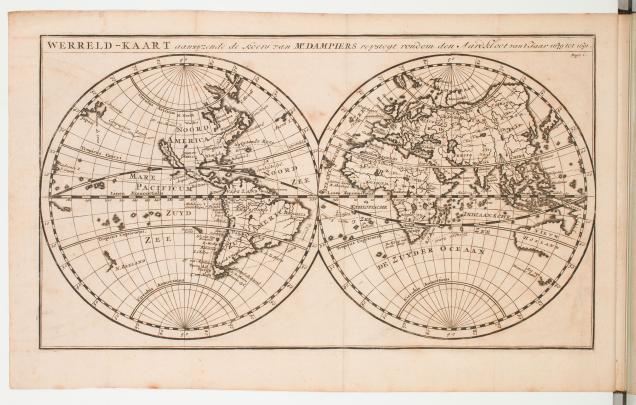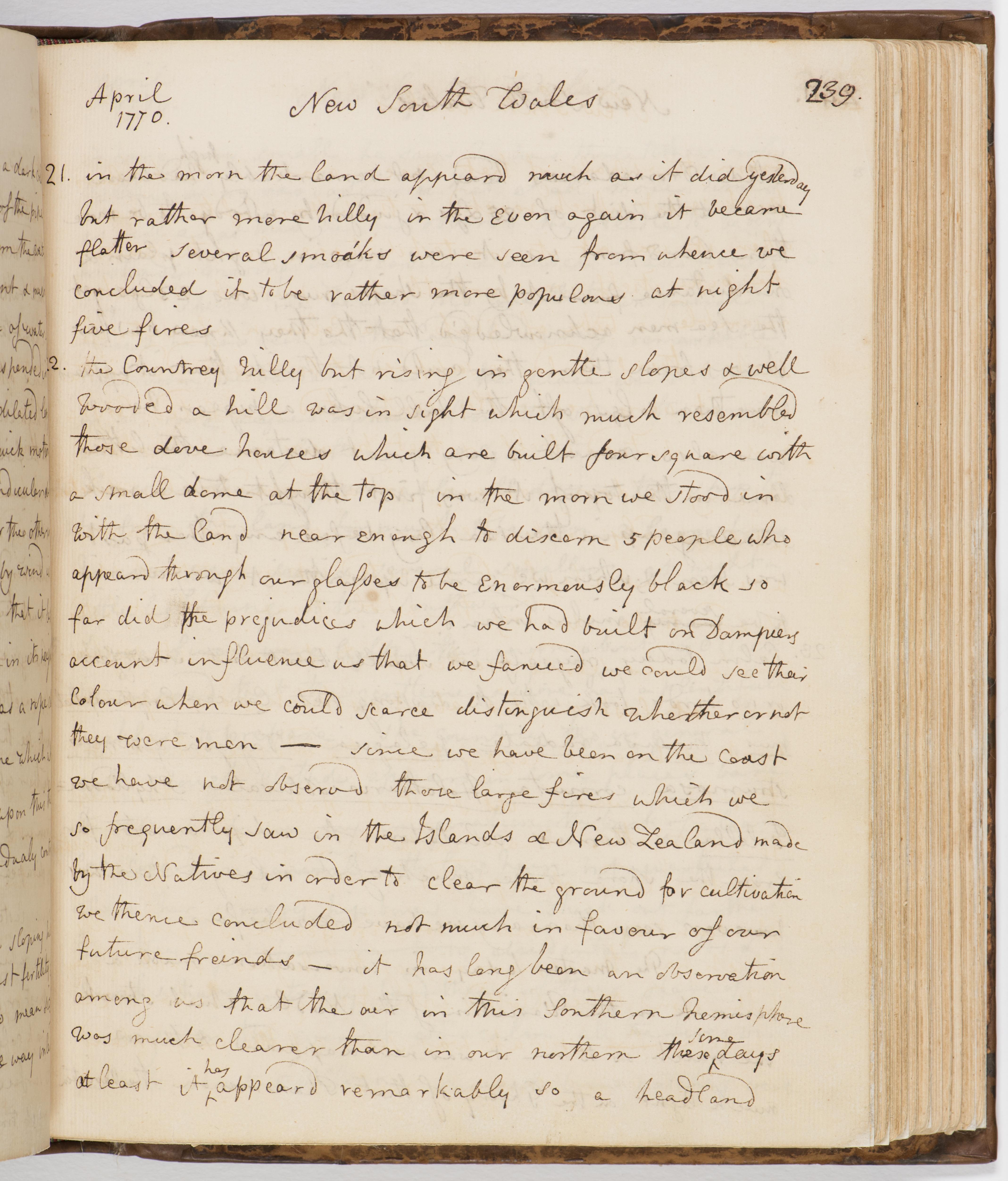Perspective and power
This is the student activity 1 of 8 of the Cook: it was only eight days learning activity.

Key inquiry question #1
How did prior knowledge influence the behaviour of the British towards the Gweagal people?
First impressions

All explorers used information from those who had explored far reaches of the world before them. They learnt from the past, much like we can learn from history. Cook was no exception. When it came to the Indigenous people of Australia, the journals of William Dampier were to be a significant influence on his expedition’s beliefs and attitudes towards the Gweagal people.
Dampier had spent almost two months in northern Western Australia in 1688 and wrote extensively of the landscape, plants, animals and Aboriginal people he encountered.
You can look at part of a map that Dampier created during this time, which is in the Library’s collections, in our online exhibition, Eight Days in Kamay, here.
Dampier, however, saw the Aboriginal people he encountered as violent and primitive and wrote that they were both simple and savage. His account of the natural environment, people and their way of life was very negative. Dampier said things like:
The land is of a dry sandy soil, destitute of water except you make wells; yet producing divers sorts of trees; but the woods are not thick, nor the trees very big…
The inhabitants of this country are the miserablest people in the world … they differ but little from brutes
They are long-visaged, and of a very unpleasing aspect, having no one graceful feature in their faces
They have no instruments to catch great fish
There is neither herb, root, pulse, nor any sort of grain for them to eat that we saw; nor any sort of bird or beast that they can catch, having no instruments wherewithal to do so.
I did not perceive that they did worship anything. These poor creatures have a sort of weapon to defend their weir or fight with their enemies if they have any that will interfere with their poor fishery. (William Dampier, 1697, A New Voyage Round the World)
Dampier’s attitude towards Indigenous Australians would have fed into European beliefs that they were more capable and important people. His book, A New Voyage Round the World, was published in 1697 and was very popular. Cook and Banks took a copy of Dampier’s book with them on the Endeavour, and Banks talks about how Dampier’s thoughts about Indigenous Australians influenced their thinking. On 22 April 1770, Banks wrote:
In the morn we stood in with the land near enough to discern 5 people who appeard through our glasses to be enormously black: so far did the prejudices which we had built on Dampiers account influence us that we fancied we could see their Colour when we could scarce distinguish whether or not they were men.
You can look at where Banks wrote these words in his journal, which is in the Library's collections, below.
Dampier’s opinion of the Indigenous people of Australia was no doubt very present in the minds of Cook and Banks.
Imagine how Dampier’s words might have influenced Cook’s and Banks’ first impressions of the Gweagal people when they met?
Answer the following:
- How might Dampier’s words have affected the way the Endeavour expedition behaved towards the Gweagal people during their landing on the beach at Kamay?
- How might Dampier’s ideas about Indigenous Australians have changed how the Endeavour expedition approached the houses and belongings of the Gweagal people?
Imagine what might have happened during those eight days in Kamay if Cook and Banks had not read Dampier’s words, but instead only heard positive accounts of the Indigenous people of Australia? What if they had read a book by someone who had recognised that people have different ways of living, and saw this as an interesting and positive thing. Imagine Cook’s and Banks’ first impressions had been influenced by someone who believed Europeans had much to learn from people who lived differently.
Imagine you are Banks. Write about your time in Kamay from this perspective. Talk about what you thought when you first saw the Gweagal people standing on the shore, how you negotiated the landing on the beach in Kamay, what you did when you came upon the houses of the Gweagal people and what you might have done when it came time to sketch botanical specimens and write about what they were used for.
Remembering Tupaia
When Cook and the Endeavour left Tahiti, they took with them a man called Tupaia, a Polynesian navigator. Banks convinced Cook to take Tupaia with them because of his knowledge of both the geography and people of the South Pacific.
Recruited primarily to act as a translator and mediator between the Endeavour and the people of the South Pacific, Tupaia was also a highly skilled navigator and explorer, and proved to be useful to Cook as they journeyed to and around New Zealand.
In our exhibition, Eight Days in Kamay, you can see a map Tupaia drew of the Society Islands, which Cook copied. Tupaia’s knowledge of the Pacific had been inherited from his ancestors, who had been exploring the area for hundreds of years. It was indispensible to the British. This map now lives in the British Library in London. Look at it, here.
Tupaia was of enormous assistance to Cook in navigating the South Pacific and in his dealings with the Maori people of New Zealand, as he understood their language and was understood by them, and was also highly respected. Banks wrote in his journal on 19 March 1770:
We never expected him to have so much influence
Tupaia was on board the boat that landed in Kamay. Cook wrote in his diary on 28 April 1770:
Saw, as we came in, on both points of the bay, several of the Natives and a few hutts; Men, Women, and Children on the South Shore abreast of the Ship, to which place I went in the Boats in hopes of speaking with them, accompanied by Mr. Banks, Dr. Solander, and Tupia.
You can look at where Cook wrote these words in his journal, in the collection item below.
However, it quickly became apparent that, where the Maori language shared enough in common with Tupaia’s language for there to be mutual understanding, the same could not be said for the Dharawal language spoken by the Gweagal people. His language was as strange to the Gweagal people as that of the Europeans. Consequently, Tupaia was no longer of any use to Cook.
Although we are left with a beautiful image drawn by Tupaia of the Gweagal people in their nawi (canoes), which you can look at in the exhibition Eight Days in Kamay, here, little more of Tupaia’s story is known. He died in Jakarta in November that year, while the Endeavour was stopped there, from an illness he contracted on board the ship. The whereabouts of his grave is not known.
Tupaia’s important contribution to the Endeavour journey has never been recognised in history in the same way as Cook. Where Cook’s name is very well known, Tupaia, despite his very important role, is little known.
Discuss the following:
- When the Endeavour arrives in Kamay and Cook realises Tupaia is no longer of any use to them, he is largely marginalised (look this word up, if you need to). What does this say about Cook’s attitude towards Tupaia? Consider the fact that Tupaia was an Indigenous person from the Pacific Island of Rai’atea.
- How have our attitudes towards Indigenous peoples changed in the 250 years since the Endeavour came to Kamay?
- How can we demonstrate that we value and acknowledge Indigenous people, their cultures and knowledge, in our communities?
- How should we learn from the misunderstandings of the past, that led to the behaviours we have been looking at, and ensure a happier future?
Did you know this learning activity was just one in a series? To find more, click here.